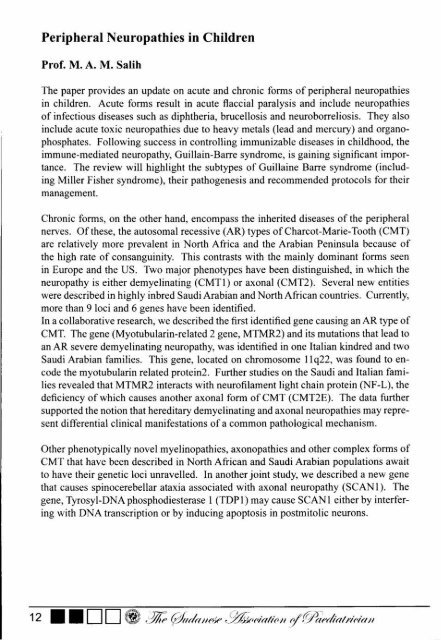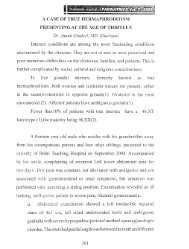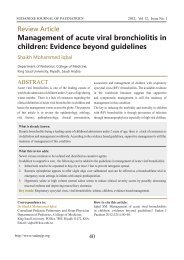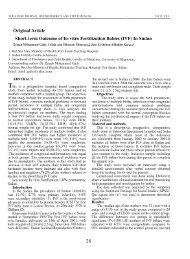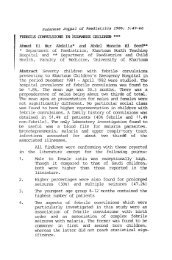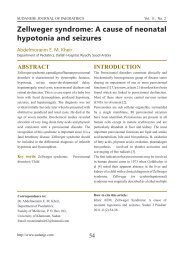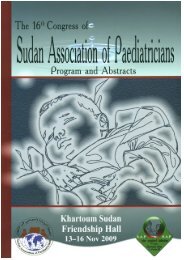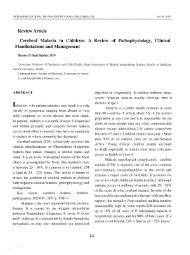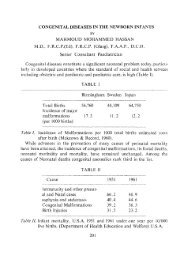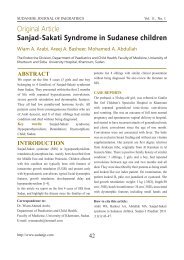conference programme and abstracts book - Sudanjp.org
conference programme and abstracts book - Sudanjp.org
conference programme and abstracts book - Sudanjp.org
You also want an ePaper? Increase the reach of your titles
YUMPU automatically turns print PDFs into web optimized ePapers that Google loves.
Peripheral Neuropathiesin ChildrenProf. M. A. M. SalihThe paper provides an update on acute <strong>and</strong> chronic forms of peripheral neuropathiesin children. Acute forms result in acute flaccial paralysis <strong>and</strong> include neuropathiesof infectious diseases such as diphtheria, brucellosis <strong>and</strong> neuroborreliosis. They alsoinclude acute toxic neuropathies due to heavy metals (lead <strong>and</strong> mercury) <strong>and</strong> <strong>org</strong>anophosphates.Following success in controlling immunizable diseases in childhood, theimmune-mediated neuropathy, Guillain-Barre syndrome, is gaining significant importance.The review will highlight the subtypes of Guillaine Barre syndrome (includingMiller Fisher syndrome), their pathogenesis <strong>and</strong> recommended protocols for theirmanagement.Chronic forms, on the other h<strong>and</strong>, encompass the inherited diseases of the peripheralnerves. Of these, the autosomal recessive (AR) types of Charcot-Marie-Tooth (CMT)are relatively more prevalent in North Africa <strong>and</strong> the Arabian Peninsula because ofthe high rate of consanguinity. This contrasts with the mainly dominant forms seenin Europe <strong>and</strong> the US. Two major phenotypes have been distinguished, in which theneuropathy is either demyelinating (CMTl) or axonal (CMT2). Several new entitieswere described in highly inbred Saudi Arabian <strong>and</strong> North African countries. Currently,more than 9 loci <strong>and</strong> 6 genes have been identified.In a collaborative research, we described the first identified gene causing an AR type ofCMT. The gene (Myotubularin-related 2 gene, MTMR2) <strong>and</strong> its mutations that lead toan AR severe demyelinating neuropathy, was identified in one Italian kindred <strong>and</strong> twoSaudi Arabian families. This gene, located on chromosome 11q22, was found to encodethe myotubularin related protein2. Further studies on the Saudi <strong>and</strong> Italian familiesrevealed that MTMR2 interacts with neurofilament light chain protein (NF-L), thedeficiency of which causes another axonal form of CMT (CMT2E). The data furthersupported the notion that hereditary demyelinating <strong>and</strong> axonal neuropathies may representdifferential clinical manifestations of a common pathological mechanism.Other phenotypically novel myelinopathies, axonopathies <strong>and</strong> other complex forms ofCMT that have been described in North African <strong>and</strong> Saudi Arabian populations awaitto have their genetic loci unravelled. In another joint study, we described a new genethat causes spinocerebellar ataxia associated with axonal neuropathy (SCAN 1). Thegene, Tyrosyl-DNA phosphodiesterase 1 (TDP 1) may cause SCAN I either by interferingwith DNA transcription or by inducing apoptosis in postmitolic neurons.


